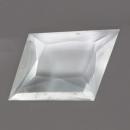|
|
|
|
Click on a letter above to view the list of gems. |
|
|
|
|
|
Gypsum
(Selenite) |
|
| Chemistry: CaSO4 •2H2O [Hydrated Calcium Sulfate] | |
| Discovered
in Prehistory;
IMA
status: (Gypsum) Valid (pre-IMA; Grandfathered). | ||
|
| ||
|
Classification |
|
|
| |
|
Sulfates | |
|
6/C.22-20 | |
|
|
7 : SULFATES (selenates, tellurates, chromates, molybdates,
wolframates) |
|
Related to: |
Isostructural with Brushite. Hydrated form of Anhydrite. |
|
|
|
|
Crystal Data |
|
|
|
|
|
Crystals as acicular to stubby prismatic crystals, thin to thick tabular, with more than 20 other forms noted, coarsely striated, to 17 m; lenticular in rosettes, may be curved, bent; fibrous, earthy, concretionary, granular, massive. |
|
|
Very common forming cruciform and V-shaped twins; as butterfly or heart-shaped twins. |
|
|
|
|
|
Physical Properties |
|
|
|
|
|
[010] Perfect, [100] Distinct |
|
|
Splintery parallel to [001], conchoidal on [100] |
|
|
Flexible, Inelastic |
|
|
1.5 - 2.0 (varies with direction) |
|
|
2.317 (g/cm3) |
|
|
None |
|
|
Not Radioacitve |
|
|
Other: |
Slightly soluble in water |
|
|
|
|
Optical Properties |
|
|
|
|
|
Colorless, White; if colored by impurities, Yellow, Tan, Blue, Pink, Brown, Reddish Brown, Gray, Black |
|
|
Transparent to Translucent |
|
|
Sub-vitreous, pearly on cleavages, silky if fibrous |
|
|
1.521 - 1.530 Biaxial ( + ) |
|
|
0.166 (very high) |
|
|
Strong; r > v |
|
|
n/a |
|
|
|
|
|
Occurances |
|
|
|
|
|
Geological Setting: |
Commonest of the sulphate minerals, gypsum is found in marine evaporites, in caves where the air is dry enough to allow it to be deposited and remain, at fumaroles, and in the oxidized zones of sulfide deposits on occasion. A common constituent of sedimentary rocks, particularly marine salt deposits, and soils formed directly by evaporation or later by hydration of anhydrite. Formed by the reaction between sulfuric acid and carbonate rock in oxidizing sulfide deposits, and by the action of sulfurous volcanic gases on surrounding Ca-bearing rock. As efflorescences in mines and speleothems in caves. |
|
Common Associations: |
Anhydrite, Aragonite, Calcite, Celestine, Dolomite, Halite, Sulfur |
|
Type Locality: |
n/a |
|
Year Discovered: |
Prehistory |
|
View mineral photos: |
Gypsum
Mineral Photos and Locations |
|
|
|
|
More Information |
|
|
|
|
|
| |
|
|
|
|
There are many locations for Gypsum but only
a few locations for gem quality Selenite crystals including
Rio Grande do Sul, South Region, Brazil;
Willow Creek, Nanton, Alberta, Canada; Liupanshui Prefecture, Guizhou Province, China. |
|
|
We
have not photographed our Gypsum
(Selenite) gems. Please
check back soon. |
